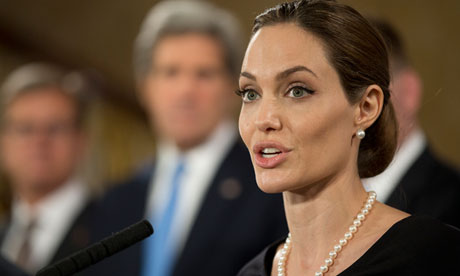
I did a double take when I saw the headline announcing that Angelina Jolie has recently had a double mastectomy.
The woman who has kept stealing headlines for years with her beautiful babies and her beautiful baby daddy, her charitable works and her constantly evolving career was brave enough to put her human vulnerability out there for public consumption in an op-ed in the New York Times titled My Medical Choice. Her goal was to encourage other women at high risk of developing cancer to explore their choices and to take whatever steps may be necessary to save their own lives. Unfortunately the reality for many women in America and elsewhere is that quite often when it comes to making decisions about their health, they often have no choice at all.
In her op-ed, Angelina disclosed that she carries the BRCA1 gene that meant in her case that she had an 87% chance of getting breast cancer and a 50% chance of getting ovarian cancer. Having lost her mother prematurely to the disease at a vulnerable time when she had only recently become a mother herself, she was hyper aware of what it would mean for her children to undergo a similar loss. So she took the plunge and made the probably wise decision to have a preventable double mastectomy.
As a person with breasts, I can only imagine what a difficult decision this was for her to make, (particularly as her pair have had more than their fair share of attention over the years). She acknowledged that the choice she made was not an easy one, but not one she regrets either, particularly as her chances of developing breast cancer since having the procedure have dropped from 87% to less than 5%.
Many women in similar circumstances will no doubt be comforted and encouraged by her experience and her decision to share it. She does have one major advantage over a lot of women dealing with cancer or facing the prospect of developing cancer, however, and this is that for her money is not an object.
She didn't mention how much the procedure or reconstruction surgery set her back, but it's safe to assume she got the best possible care and paid top dollar for it. She did allude to the $3,000 fee for the gene test that led her to make her potentially life saving decision and pointed out that this cost alone can be an obstacle for many women. It certainly is, particularly as the test is not commonly covered by insurance, but the costs of the mastectomy itself and the reconstructive surgery can also be prohibitively expensive, even for women who have decent health insurance.
It's difficult to get an exact estimate of how much such a procedure typically costs because cases vary, insurance packages vary and surgeons' prices vary. Under the Women's Health and Cancer Rights Act (WHCRA), which was signed into law in 1998, most insurance plans that cover mastectomies are required by the law to also cover the cost of breast reconstruction. There are many criteria to be met, however, and there are always exceptions. But even though most cases deemed medically necessary will be covered, women still report having to pay out between $10,000 and $25,000 on co-pays or fees the insurance company will not pick up.
Still at least women who do have health coverage have some chance of getting the care they need. For the estimated 21 million women and girls in America who have no health insurance not only are the costs of such a procedure insurmountable, but they even face obstacles from a hostile congress to gaining access to the most basic cancer screening services.
Every year, for example, millions of women avail of Planned Parenthood, an organization that offers cancer screening services on a sliding pay scale. In 2011, the organization , such as pap smears and breast exams, which accounts for 12% of their total services. Undoubtedly many cancers are detected early because of these screenings and many lives are saved. Yet two years ago, the house of representatives approved an amendment (by a margin of 240 to 185) to cut off funding to Planned Parenthood, all because of their objections to the fact that the organization also offers women the legal medical procedure of abortion. Fortunately the bill never made it past the house but the disregard for women's health was painful to observe.
The same disregard for women's health and for poor people's health in general was evident in the viscous battle over the Affordable Care Act. Miraculously, it survived the various onslaughts, including a Supreme Court challenge, more or less intact and it should make a significant difference to women's health (pdf).
Until now, insurance companies were able to charge women more than men (sometimes 150% more) for comparable coverage and were able to deny women coverage for pre-existing conditions, such as being pregnant. As of 2014, when the act goes into effect, that will no longer be possible.
This should mean that in the near future more women will have access to health insurance and more women will be in a better position to avail of regular screenings and breast exams. This could not be more important since the National Cancer Institute estimates that around 12% of women in America will develop breast cancer in their lives.
Angelina Jolie has done a great thing by sharing her decision to make a brave choice regarding her health. I'm sure she would be the first person to agree, however, that no woman should be denied that right because of a lack of income or insurance.

